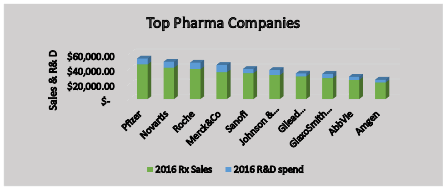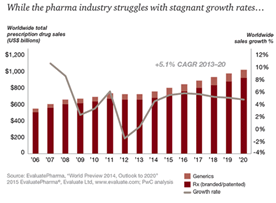Market Analysis - (2021) Volume 11, Issue 2
The pharmaceutical industry plays a significant role in developing medications and vaccines to reduce the incidence of diseases, to treat diseases and enhance the quality of life of people. The industry’s main contribution is engaging in technological advancements through innovative research to meet the complex healthcare demands of populations. The global market for pharmaceuticals is expected to grow at an annual rate of 4.9% to $1.3 trillion by 2020. The U.S pharma market is expected to grow to $320 billion by 2020. The Japan market, the third largest pharmaceutical market, has a forecasted growth of 3% while the U.S has an expected growth rate of 5.6%.
Market Analysis
Key Players in the Industry
Pharma companies experienced modest revenue gains in the past year with rising prices, main patent losses for some pharma companies as well as a decline in M&A activity. Merck & Co is currently ranked No.1 in R&D, although it is fourth in sales. Pfizer remains the top industry prescription sales leader.
Revenues and R&D of Top Pharma Companies

Several major trends are reshaping the pharmaceutical industry and may cause challenges for pharma companies
• Healthcare budgets are experiencing greater pressure due to the rising incidence of chronic diseases
• Increase in demand for medicines in emerging economies compared to industrialized economies
• Innovative medicines are influencing regulators to become more cautious about approving new medicines.
• Drug-pricing concerns will worsen
Companies such as AstraZeneca (AZN) and Norvatis are experiencing challenges with growth while its competitors such as Johnson & Johnson, Allergan and Merck & Co. had increased firepower in 2016, giving them a competitive advantage for acquisitions.[19] Pharma companies will have to enhance their growth strategies and use alternative methods to supplement growth. Based on a PwC analysis, pharmaceutical industries are struggling with sales.
PwC Analysis on Pharma Industry

One of the challenges that pharma companies are facing is developing a smart multi-channel strategy to use the appropriate medium to deliver promotions and the right information to customers. Pharma companies that had negative publicity in the past must fix their reputational damage. Dubious promotional practices, exploitation of market monopolies and drug pricing in developing countries has affected their public trust and must be mended.
Overregulation is an issue that pharma companies are constantly facing. It is perceived as a threat with pricing pressures and possible changes in the U.S pharmaceutical market.
Opportunities
The pharmaceutical industry looks forward to several opportunities in the future. More than 220 drugs are expected to be introduced in the pharma market by 2021. Most of the drug manufacturing will be outsourced. Pharma companies have opportunities to develop new businesses and increase market share by outsourcing manufacturers. As pharma companies lose sales due to increase in generic drugs, the companies can create portfolios of generic pharmaceutical ingredients (APIs) and present the generic APIs to customers. Outsourcing is expected to increase and provide pharma companies with $105.0 billion in 2021.
A survey showed that pharma CEOs choose innovation as an area to capitalize on for opportunities in the future. Pharma companies are more driven to be innovative than most sectors. Human capital is a second area of opportunity that pharma companies will like to focus on.
Journal of Blood & Lymph received 443 citations as per Google Scholar report